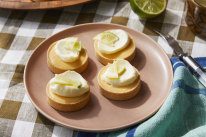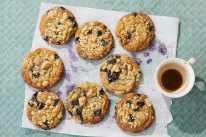Patience and grunt work: Emelia Jackson’s secrets to making the perfect pavlova
So many things can go wrong with Australia’s best-known dessert. Follow these simple tricks, and you’ll have the crisp, snowy meringue of your dreams.
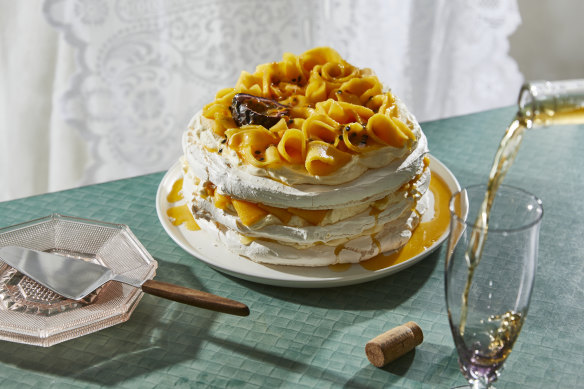
I’m often asked: how do I make a good pavlova? There’s so much that can go wrong, including weeping droplets of sugar syrup, over-browning, not crisping up, and disintegrating when handled. This pavlova stack solves all those issues. By spreading the meringue into thin layers, the pavlova bakes in less time and achieves that crisp exterior we all search for – and it looks spectacular.
Technique of the month: The perfect pavlova
The perfect pavlova begins with the perfect meringue, and achieving that requires both patience and grunt work.
Start with a very clean mixing bowl. Wash it with hot soapy water, then take the extra step of wiping out the mixing bowl with a dash of white vinegar to ensure you’ve removed all the fat.
Next, add the egg whites and begin to whisk on medium speed until they’re light and foamy.
Finally, rain in the sugar one tablespoon at a time until the sugar has completely dissolved. This is the grunt work: the mixer needs to whisk for a good 12 to 14 minutes to ensure the sugar has completely dissolved. Undissolved sugar is often the root of all evil when it comes to pavlova; sugar weeping, sinking, and cracking.
Ingredients
4 egg whites (120g)
220g caster sugar
10ml vinegar
10g cornflour
To serve
600g thickened cream, whipped to stiff peaks
1-2 mangoes, finely sliced
pulp from 3 passionfruit
Method
Step 1
Place the egg whites into the bowl of a stand mixer fitted with the whisk attachment. On medium speed, whisk the egg whites until soft peaks have formed before beginning to add the sugar. Add the sugar 1 tablespoon at a time, whisking for 1-2 minutes between each spoonful. Continue to whisk the meringue mixture for 12-14 minutes or until the sugar has completely dissolved when rubbed between your fingers.
Step 2
Combine the vinegar and cornflour in a small bowl and fold through 1-2 tablespoons of the meringue mixture. Once mixed thoroughly, add this mixture into the meringue and fold together.
Step 3
Line three baking trays with baking paper and preheat the oven to 100C fan-forced (120C conventional). Spread a third of the pavlova mixture onto each baking tray, roughly in a 24cm circle. Bake the pavs for 1 hour and 15 minutes before turning the oven off and allowing the pavs to cool completely in there (overnight is best).
Step 4
To assemble the stack, place a little whipped cream onto the serving plate to secure and place the first pavlova round down. Top with ⅓ of the cream, and scatter about some of the mango and the pulp of 1 passionfruit. Add the remaining pavlovas and repeat the process. To decorate the top, I like to slice one mango cheek into thin ribbons and arrange in curls.
Tips
Many things can go wrong with a pavlova. Here’s how to avoid the main issues.
- Whisk the egg white and sugar for long enough (but not too long): We want to completely dissolve the sugar, so whisk the meringue for a good 15 to 20 minutes. If you can still feel sugar when you rub the meringue between your fingers, it needs more whisking. Dissolving the sugar helps to prevent the pavlova from weeping.
- Watch your mixing speed: You might be tempted to crank the mixer up to high speed, but in all of my testing, I’ve found mixing the meringue at medium speed for longer yields greater volume and also better dissolves the sugar.
- Bake low and slow: I cook the meringues at 100C fan-forced (120C conventional). If cracking occurs within the first 15 minutes, the oven is probably too hot. Every oven runs differently so if you’re unsure, grab yourself an oven thermometer.
- Add cornflour and vinegar to the meringue: This does three things: it creates that chewy marshmallow texture we want, reduces potential weeping, and also helps reduce the flavour of the egg.
Appears in these collections
The best recipes from Australia's leading chefs straight to your inbox.
Sign up- More:
- Better baking
- Eggs
- Mango
- Passionfruit
- Cream & milk
- Nut-free
- Gluten-free
- Modern Australian
- Fruit desserts
- Dessert
- Entertaining
- Dinner party
- Summer barbecue
- Christmas
- Kid-friendly
From our partners
Similar Recipes
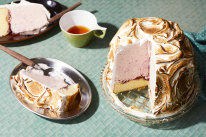
Looking for the ultimate party pud? Emelia Jackson’s retro ice-cream cake is the bombe
- 30 mins - 1 hr
- Emelia Jackson
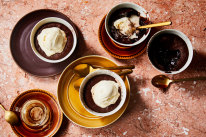
Emelia Jackson’s no-stress, soft-centred chocolate puddings make a deliciously simple dessert
- 30 mins - 1 hr
- Emelia Jackson

